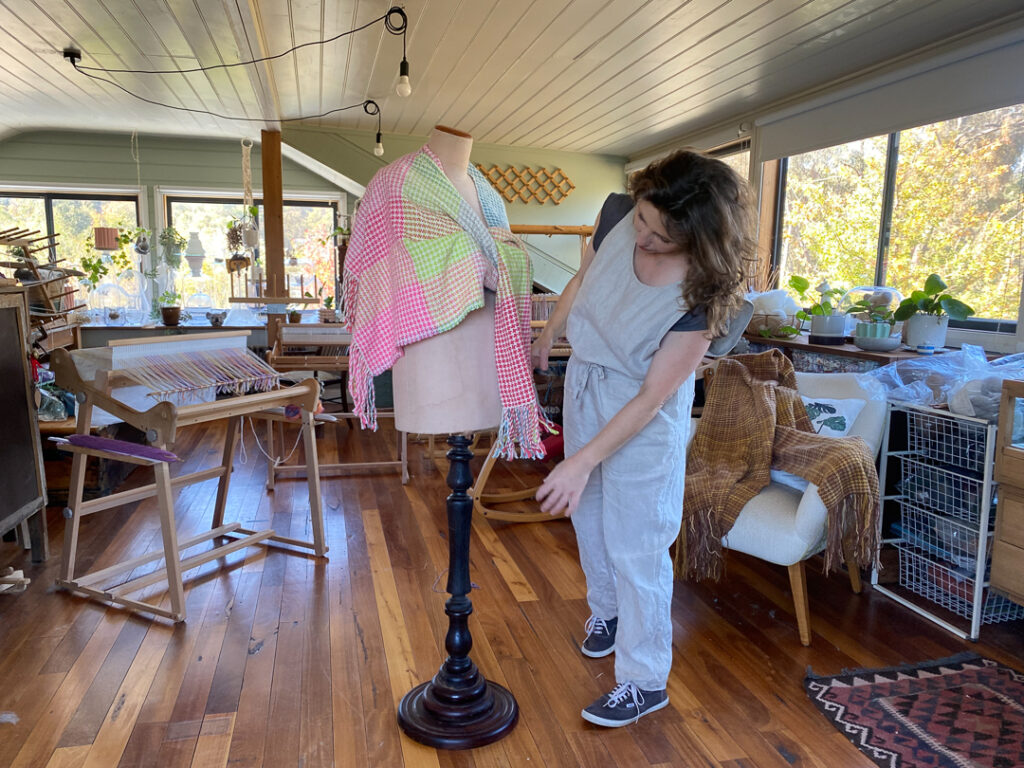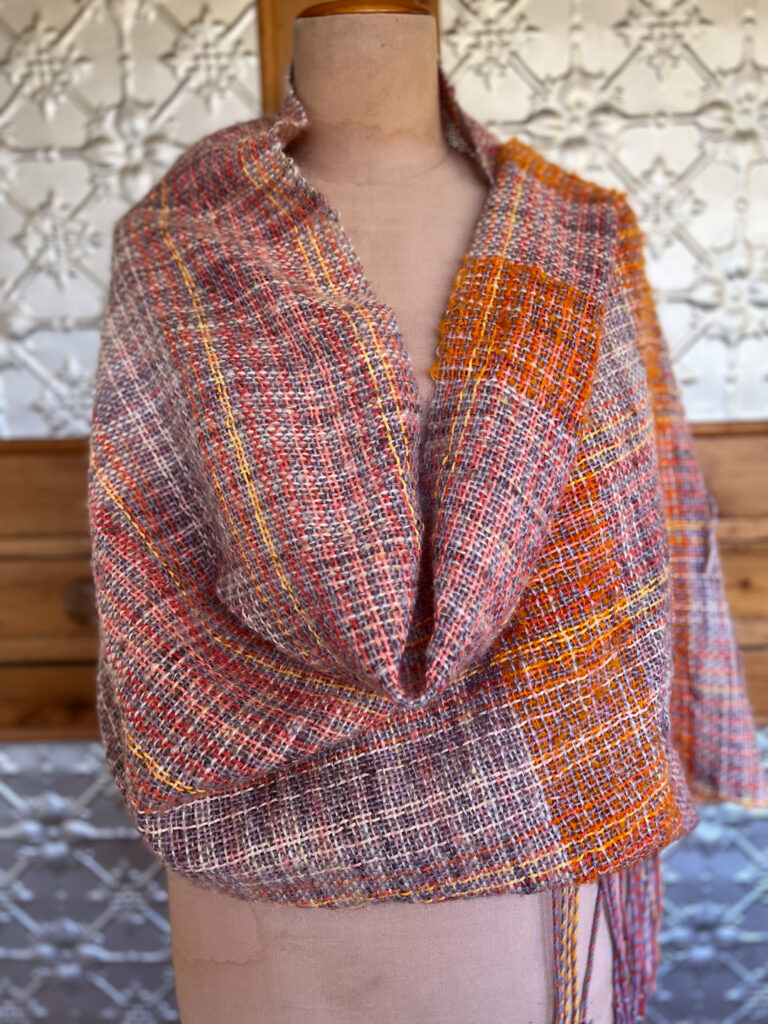Douglas Brodie asks Louiseann King about falling in love with alpacas and the processes involved in weaving shawls from their wool.
Neighbours and friends Douglas Brodie and Louiseann King share many interests, including philosophy, nature and sustainability. Over the last few years, King’s menagerie on her Eganstown property where she lives with her family on Dja Dja Wurrung land has become home to a growing herd of beloved alpacas. For Garland, Brodie and King share their conversation.
Douglas Brodie: So Louiseann, I’ve spent a lot of time at your property and with your alpacas, and hugely admire your weaving, but I don’t think I’ve ever asked you how you came to alpaca husbandry or, in your case, ‘mother-ry’.
Louiseann King: For me, it’s always been about love. I, inadvertently, fell in love with an orphaned cria (baby alpaca) whilst acquiring some goats for weed management around 5 years ago. The farmer told me this cria (who was to become my beloved Esther) would need a small herd to thrive. So, over the course of a weekend, I brought into our lives hembras (female alpacas) Freya and Charlotte, Polyanna and her cria Ella. Alpacas need to be kept in sex-specific herds – I have girls.
DB: Wow, so it was entirely spontaneous?
LK: Actually not all spontaneous. We brought home the goats. But I just couldn’t get that cria out of my mind. I had fallen in love. I researched alpacas, spoke to breeders, and found out what was required for alpaca care. I then made a plan to acquire a small herd, including an alpaca mum and cria so that Esther would have a friend her own age, and I’ve been on a steep learning curve ever since. I found myself becoming an “alpaca midwife” when it became clear that Freya’s cria was stuck. He was malpositioned and, with no veterinary assistance available and my alpaca mentor on her way but an hours drive away, I knew I had to help and found that I, somehow, knew what to do. Both Freya and I were much relieved when I delivered her healthy cria.
DB: What do you think it was about Esther, and perhaps alpacas more generally? I still laugh when I find you out in the field in a sort of alpaca-mum reverie.
LK: There’s so much to love about alpacas, but its their almost-otherworldliness that captivates me. From their beguiling faces to gentle hums, soft fleece, their dislike of hands and their love of faces. They’re reminiscent of the PushMePullYou creatures from Dr. Doolittle. Alpacas are so gentle, yet fierce protectors. They need their community and will die of fatigue if alone, as they take their share of sentry duty seriously. Their designated communal “toilet” spots make for easy poo collection and this manure has been a wonderful tool in regenerating the land on our property.
DB: And, of course, their fleece is pretty special too, right? What does alpaca fleece offer that, say, merino doesn’t?
LK: Alpaca fibre is completely hollow, unlike sheep’s wool which has hollow pockets. This makes for a light but very warm fibre. It’s as luxurious and soft as cashmere, but more durable because the fibres are longer. Alpaca fleece has no lanolin and is hypoallergenic. Merino is a great fibre and combines well with alpaca, but for warmth, lightness and softness, alpaca is superior.
One of my favourite things to do with my alpacas is to gently place my forehead on theirs. The softness and warmth are exquisite and they smell of hay and sunlight.
DB: Can you tell me about the process from raw fleece to a Louiseann King weave?
LK: Alpacas need to be shorn annually. Only the best part of the fleece, the saddle, is then processed into yarn. Whilst I have held dreams about spinning my own yarn, the reality is that I’d rather be weaving and Fibre Naturally produce a superb yarn from my alpacas’ fleece so I’ll happily leave processing and spinning to them.
For me the process of weaving is deeply meditative. I predominantly weave using a rigid heddle loom. This is a 2-shaft loom ideal for plain weave. I seem to intuitively evoke the ever-changing seasons and the particular qualities of the light in the landscape that surrounds me. As a sculptor/installation artist, weaving has been an intriguing development in my practice where I find myself in a more direct relationship with my audience, the wearer, who now is fully immersed in the limitlessness of the abstract colours and sensual materiality of the woven piece. I am particularly drawn to the scale of the shawl for its inexhaustible applications in life. It travels with us from birth to death and the place between.
The photos with Louiseann King in them are by Ana Maria Silva, all others by Louiseann.
Links
- www.louiseannking.com.au
- www.kingweaving.com.au
- Australian Alpaca Association
- Handweavers and Spinners Guild of Victoria
About Louiseann King
Dr Louiseann King is a sculptor/installation artist and academic based in Eganstown, regional Victoria where she lives with her young family. Over 20 years her work has examined notions of transience, the environment, mutability, metamorphosis, value and the domestic, nationhood and time. King creates both intimate and large-scale immersive works. Visit www.louiseannking.com.au and follow @louiseannking




















